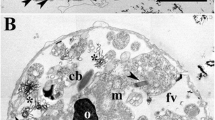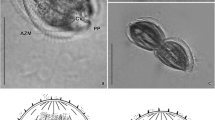Summary
The toxicysts of the ciliates Loxophyllum meleagris and Prorodon teres were examined with regard to fine structure and expulsion mechanism.
Loxophyllum possesses two morphologically distinct types of toxicysts, whereas in Prorodon only one type is present.
As can be shown by discharge inhibition experiments, the expulsion mechanisms, except for small variations, are identical in all three types: Tubes, which in their resting state lie closely packed one within the other possess already at this state their final dimensions; they are inverted, thereby leaving the capsule and thus the cell body. This process is correlated with the excretion of a substance partly filamentous, partly amorphous.
The inversion of the tubes during the expulsion is compared to the fundamentally different morphological alterations during discharge of mucocysts and spindle trichocysts.
The differences and similarities in fine structure and function between toxicysts on the one hand and mucocysts and spindle trichocysts on the other, indicate that two rather than three fundamentally different organelle types must be distinguished.
Zusammenfassung
Die Nesselkapseltrichocysten der Ciliaten Loxophyllum und Prorodon wurden hinsichtlich ihrer Feinstruktur sowie des Ausschleuderungsablaufes untersucht. Loxophyllum besitzt zwei morphologisch unterscheidbare Sorten von Toxicysten, wohingegen Prorodon nur eine Art dieser Organelle aufweist (Krüger, 1936).
Wie an Hand gehemmter Stadien gezeigt werden kann, verläuft die Ausschleuderung bis auf geringfügige Variationen bei den drei Sorten in der gleichen Art: Schläuche, die im ruhenden Zustand bereits in den endgültigen Dimensionen in der Toxicystenkapsel eng ineinandergeschachtelt vorliegen, werden handschuhfingerförmig umgestülpt und verlassen hierdurch die Kapsel und damit den Zellkörper. Dieser Prozeß ist mit der Ausscheidung einer teils fädigen, teils amorphen Substanz gekoppelt.
Der Umstülpungsvorgang der Innenstruktur der Nesselkapseltrichocysten wird mit den völlig andersartigen, während der Ausschleuderung von Mucocysten und Spindeltrichocysten ablaufenden morphologischen Veränderungen verglichen.
Es zeigte sich, daß aufgrund ihrer differierenden Feinstrukturen und Funktionsweisen in den Nesselkapseltrichocysten einerseits und in den Mucocysten sowie Spindeltrichocysten andererseits zwei grundsätzlich voneinander verschiedene Organellentypen gesehen werden müssen.
Similar content being viewed by others
Literatur
Anderson, E.: A cytological study of Chilomonas paramecium with particular reference to the so-called trichocysts. J. Protozool. 9, 380–395 (1962).
Bannister, L. H.: The structure of trichocysts in Paramecium caudatum. J. Cell Sci. 11, 899–929 (1972).
Bouck, B. G., Sweeney, B. M.: The fine structure and ontogeny of trichocysts in marine dinoflagellates. Protoplasma (Wien) 61, 205–223 (1966).
Brettschneider, L. H.: Elektronenmikroskopische Untersuchung einiger Ziliaten. Mikroskopie 5, 257–269 (1950).
Chatton, E.: Les cnidocystes du peridinien Polykrikos schwartzi Bütschli. Structure, fonctionemment, ontogenese, homologies. Arch. zool. exp. gen. 54, 157–194 (1914).
Chatton, E., Hovasse, R.: Sur les premiers stades de la cnidogénesè chez le peridinien Polykrikos schwartzi. C. R. Acad. Sci. (Paris) 218, 60 (1944).
Dodge, J. D., Crawford, R. M.: Fine structure of the dinoflagellate Amphidinium carteri Hulburt. Protistologica 4, 231–242 (1968).
Dodge, J. D., Crawford, R. M.: Fine structure of the dinoflagellate Oxyrrhis marina. I. The general structure of the cell. Protistologica 7, 295–304 (1971a).
Dodge, J. D., Crawford, R. M.: Fine structure of the dinoflagellate Oxyrrhis marina. II. The flagellar system. Protistologica 7, 399–409 (1971b).
Dragesco, J.: The mucoid trichocysts of flagellates and ciliates. Proc. Soc. Protozool. 3, 15 (1952a).
Dragesco, J.: Sur la structure des trichocysts toxiques des infusoires holotriches gymnostomes. Bull. Micr. appl. 2, 92–98 (1952b).
Dragesco, J., Auderset, G., Baumann, M.: Observations sur la structure et la génèse des trichocystes toxiques et des protrichocystes de Dileptus (Ciliés Holotriches). Protistologica 1, 81–90 (1965).
Dragesco, J., Hollande, A.: Sur la présence des trichocystes fibreux chez les peridinens; leur homologie avec les trichocystes fusiformes des ciliés. C. R. Acad. Sci. (Paris) 260, 2073–2076 (1965).
Grain, J.: La génèse des mucocystes dans les formes prékystiques du cilié Balantidium elongatum. J. Microscopie 7, 993–1006 (1968).
Grain, J., Golinska, K.: Structure et ultrastructure de Dileptus cygnus Claparède et Lachmann, 1859, cilié holotriche gymnostome. Protistologica 5, 269–291 (1969).
Grassé, P. P., Mugard, H.: Les organites mucifères et la formation du kyste chez Ophryoglena mucifera. Progr. Protozool. (Prag) 417–418 (1963).
Hausmann, E., Hausmann, K.: Cytologische Studien an Trichocysten. VII. Die Feinstruktur der Trichocystenwarzen von Loxophyllum meleagris, Protistologica (im Druck).
Hausmann, K.: Die „Extrusome“ der Protisten. Mikrokosmos 61, 114–117 (1972a).
Hausmann, K.: Cytologische Studien an Trichocysten. III. Die Feinstruktur ausgeschiedener Mucocysten von Tetrahymena pyriformis. Cytobiologie 5, 468–474 (1972b).
Hausmann, K.: Die Nesselkapseltrichocysten des Ciliaten Loxophyllum meleagris. Mikrokosmos 61, 134–135 (1972c).
Hausmann, K.: Cytologische Studien an Trichocysten. IV. Die Feinstruktur ruhender und ausgeschiedener Protrichocysten von Loxophyllum, Tetrahymena, Prorodon und Lacrymaria. Protistologica (im Druck a).
Hausmann, K.: Cytologische Studien an Trichocysten. V. Zum Ausscheidungsmodus der Mucocysten von Loxophyllum meleagris. Protistologica (im Druck b).
Hausmann, K.: Cytologische Studien an Trichocysten. VI. Die Trichocysten des Flagellaten Oxyrrhis marina und des Ciliaten Pleuronema marinum. Feinstruktur und Funktionsmodus. Helgoländer wiss. Meeresunters. (im Druck c).
Hausmann, K., Stockem, W., Wohlfarth-Bottermann, K. E.: Cytologische Studien an Trichocysten. I. Die Feinstruktur der gestreckten Spindeltrichocyste von Paramecium caudatum. Cytobiologie 5, 208–227 (1972a).
Hausmann, K., Stockem, W., Wohlfarth-Bottermann, K. E.: Cytologische Studien an Trichocysten. II. Die Feinstruktur ruhender und gehemmter Spindeltrichocysten von Paramecium caudatum. Cytobiologie 5, 228–246 (1972b).
Hausmann, K., Stockem, W.: Cytologische Studien über die Feinstruktur und den Ausschleuderungsmechanismus verschiedener Trichocystentypen. Microscopica Acta (im Druck).
Hovasse, R.: Quelques faits nouveaux concernant les trichocystes et nématocystes des Polykrikos (Dinoflagellés). Arch. zool. exp. gen. 102, 189–198 (1963).
Hovasse, R.: Trichocystes, corps trichocystoides, cnidocystes et colloblastes. Protoplasmatologica 3, 1–57 (1965a).
Hovasse, R.: La détente des trichocystes des cryptomonadines rendue explicable grâce à l'étude des particules «K» de Paramecium aurelia de race «killer». C. R. Acad. Sci. (Paris) 261, 2947–2949 (1965b).
Hovasse, R.: Trichocystes au corps trichocystoides, et nématocystes chez les protistes. Ann. Stat. Biol. De-Besse-En-Chandesse 4, 245–269 (1969).
Hovasse, R., Mignot, J.-P., Joyon, L.: Nouvelles observations sur les trichocystes des crytomonadines et le «R-bodies» des particules Kappa de Paramecium aurelia killer. Protistologica 3, 241–255 (1967).
Jakus, M. A.: The structure and properties of the trichocysts of Paramecium. J. exp. Zool. 100, 457–476 (1945).
Jakus, M. A., Hall, C. E.: Electron microscope observations of the trichocysts and cilia of Paramecium. Biol. Bull. 91, 141–144 (1946).
Krüger, F.: Dunkelfelduntersuchungen an den Trichocysten von Paramecium caudatum. Verh. d. Dtsch. Zool. Ges. 267–272 (1929).
Krüger, F.: Untersuchungen über den Bau und die Funktion der Trichocysten von Paramecium caudatum. Arch. Protistenk. 72, 91–134 (1930).
Krüger, F.: Dunkelfelduntersuchungen über den Bau der Trichocysten von Frontonia leucas. Arch. Protistenk. 74, 207–235 (1931a).
Krüger, F.: Ultramikroskopische Untersuchungen über die nesselkapselähnliche Struktur einiger Trichocysten. Verh. d. Dtsch. Zool. Ges. 139–196 (1931b).
Krüger, F.: Epistylis umbellaria mit „Nesselkapseln“. Verh. d. Dtsch. Zool. Ges. 262–263 (1933).
Krüger, F.: Bemerkungen über Flagellatentrichocysten. Arch. Protistenk. 83, 321–333 (1934a).
Krüger, F.: Untersuchungen über die Trichocysten einiger Porodon-Arten. Arch. Protistenk. 83, 275–320 (1934b).
Krüger, F.: Die Trichocysten der Ciliaten im Dunkelfeldbild. Zoologica 34, 1–83 (1936).
Krüger, F., Wohlfarth-Bottermann, K. E.: Elektronenoptische Beobachtungen an Ciliatenorganellen. Mikroskopie 7, 121–130 (1952).
Krüger, F., Wohlfarth-Bottermann, K. E., Pfefferkorn, G.: Protistenstudien III. Die Trichocysten von Uronema marinum Dujardin. Z. Naturforsch. 7b, 407–410 (1952).
Kushida, H.: A styrene methacrylate resin embedding method for ultrathin sectioning. J. Electronmicr. 10, 16–19 (1961).
Messer, G., Ben-Shaul, Y.: Fine structure of trichocysts fibrils of the dinoflagellate Peridinium westii. J. Ultrastruct. Res. 37, 94–104 (1971).
Mignot, J.-P., Hovasse, R., Joyon, L.: Nouvelles données sur le fonctionnement des trichocystes (= taeniobolocystes) des cryptomonadines. J. Microscopie 9, 127–132 (1970).
Nemetschek, Th., Hofmann, U., Wohlfarth-Bottermann, K. E.: Die Querstreifung der Paramecium-Trichocysten. Z. Naturforsch. 8b, 383–384 (1953).
Parducz, B.: Eine neue Schnellfixierungsmethode im Dienste der Protistenforschung und des Unterrichts. Ann. Mus. Nat. Hung. 2, 5–12 (1952).
Puytorac, P.: Sur l'ultrastructure des trichocystes mucifères chez le cilié Holophrya vesiculosa Kahl. C. R. Soc. Biol. (Paris) 158, 526–528 (1964).
Reimer, L.: Elektronenmikroskopische Untersuchungs- und Präparationsmethoden. Berlin-Heidelberg-New York: Springer 1967.
Rieder, N.: Elektronenoptische Untersuchungen an Didinium nasutum O. F. Müller (Ciliata, Gymnostomata) in Interphase und Teilung. Forma et functio 4, 46–86 (1971).
Romeis, B.: Mikroskopische Technik. München-Wien: R. Oldenbourg Verlag 1968.
Rouiller, Ch., Fauré-Fremiet, E.: L'ultrastructure des trichocystes fusiformes de Frontonia atra. Bull. Micr. appl. 7, 135–139 (1957).
Sabatini, D. D., Bensch, K., Barrnett, R. J.: Cytochemistry and electron microscopy. The preservation of cellular ultrastructure and enzymatic activity by aldehyde fixation. J. Cell Biol. 17, 19–58 (1963).
Satir, B., Schooley, C., Satir, P.: Membrane reorganization during secretion in Tetrahymena. Nature (Lond.) New Biol. 235, 53–54 (1972).
Schmidt, W. J.: Über die Doppelbrechung der Trichocyste von Paramecium. Arch. Protistenk. 92, 527–538 (1939).
Schneider, L., Wohlfarth-Bottermann, K. E.: Grenzstrukturen und Hüllen bei Bakterien und Protisten. Studium gen. 17, 95–124 (1964).
Schuster, F. L.: The gullet and trichocysts of Cryptomonas truncata. Exp. Cell Res. 49, 277–284 (1968).
Steers, E., Beisson, J., Marchesi, V. T.: A structural protein extracted from the trichocyst of Paramecium aurelia. Exp. Cell Res. 57, 392–396 (1969).
Stockem, W.: Die Eignung von Pioloform F für die Herstellung elektronenmikroskopischer Trägerfilme. Mikroskopie 26, 185–189 (1970a).
Stockem, W.: Negativ-kontrastierte Trichocysten von Paramecium. Societé francaise de microscopie électronique. Septième Congrès International De Microscopie Electronique, Grenoble, 399–400 (1970b).
Stockem, W., Komnick, H.: Erfahrung mit der Styrol-Methacrylat-Einbettung als Routinemethode für die Licht- und Elektronenmikroskopie. Mikroskopie 26, 199–203 (1970).
Stockem, W., Wohlfarth-Bottermann, K. E.: Zur Feinstruktur der Trichocysten von Paramecium. Cytobiologie 1, 420–436 (1970).
Tokuyasu, K., Scherbaum, O. H.: Ultrastructure of mucocysts and pellicle of Tetrahymena pyriformis. J. Cell Biol. 27, 67–81 (1965).
Wessenberg, H., Antipa, G.: Studies on Didinium nasutum. I. Structure and ultrastructure. Protistologica 4, 427–447 (1968).
Wessenberg, H., Antipa, G.: Capture and ingestion of Paramecium by Didinium nasutum. J. Protozool. 17, 250–270 (1970).
Wohlfarth-Bottermann, K. E.: Experimentelle und elektronenoptische Untersuchungen zur Funktion der Trichocysten von Paramecium caudatum. Arch. Protistenk. 98, 169–226 (1953).
Wohlfarth-Bottermann, K. E.: Die Kontrastierung tierischer Zellen und Gewebe im Rahmen ihrer elektronenmikroskopischen Untersuchung an ultradünnen Schnitten. Naturwissenschaften 44, 287–288 (1957).
Wohlfarth-Bottermann, K. E., Pfefferkorn, G.: Protistenstudien. I. Pro-und Nesselkapseltrichocysten der Ciliaten-Gattung Prorodon. Z. wiss. Mikr. 61, 234–248 (1953).
Wohlfarth-Bottermann, K. E., Schwantes, H. O.: Protistenstudien II. Über den isoelektrischen Punkt von Trichocysten und Cilien. Z. Naturforsch. 7b, 489–490 (1952).
Yusa, A.: An electron microscope study on regeneration of trichocysts in Paramecium caudatum. J. Protozool. 10, 253–262 (1963).
Yusa, A.: Fine structure of developing and mature trichocysts in Frontonia vesiculosa. J. Protozool. 12, 51–60 (1965).
Author information
Authors and Affiliations
Additional information
Herrn Prof. Dr. Friedrich Krüger (Hamburg-Blankenese) zu seinem 71. Geburtstag am 18. 8. 1973 gewidmet.
Rights and permissions
About this article
Cite this article
Hausmann, K., Wohlfarth-Bottermann, KE. Cytologische Studien an Trichocysten. Z.Zellforsch 140, 235–259 (1973). https://doi.org/10.1007/BF00306697
Received:
Issue Date:
DOI: https://doi.org/10.1007/BF00306697




